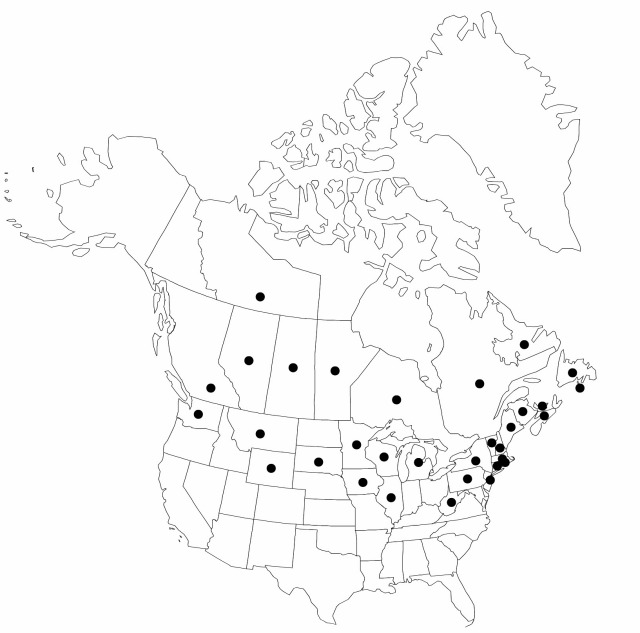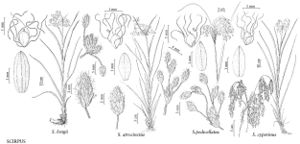Scirpus atrocinctus
Proc. Amer. Acad. Arts 34: 502. 1899.
Plants aggregated in dense tussocks; rhizomes branching, short, tough, fibrous. Culms: fertile ones upright or nearly so; nodes without axillary bulblets. Leaves 4–7 per culm; sheaths of proximal leaves brown; proximal sheaths and blades with septa few to many, conspicuous or inconspicuous; blades 25–63 cm × 3–6 mm. Inflorescences terminal; rays ascending or sometimes spreading, scabrous throughout or main branches smooth proximally, rays rarely with axillary bulblets; bases of involucral bracts usually blackish, not glutinous. Spikelets in open cymes, central spikelet of each cyme sessile, others usually pedicellate, spikelets ovoid or ellipsoid, 4–7 × 2–2.7 mm; scales usually blackish, at least distally, oblong-ovate or oblong-elliptic, 1.3–1.8 mm, apex rounded or very weakly apiculate, apiculus (if present) to 0.05 mm. Flowers: perianth bristles persistent, 6, slender, contorted, much longer than achene, smooth, projecting beyond scales, mature inflorescence appearing woolly; styles 3-fid. Achenes whitish, elliptic or obovate in outline, plumply trigonous or plano-convex, 0.7– 0.9 × 0.4–0.5 mm. 2n = 68.
Phenology: Fruiting early summer (Jun–early Jul, later in far north).
Habitat: Marshes, moist meadows, ditches, disturbed areas
Elevation: 0–800 m
Distribution

St. Pierre and Miquelon, Alta., B.C., Man., N.B., Nfld. and Labr., N.S., Ont., P.E.I., Que., Sask., Conn., Ill., Iowa, Maine, Mass., Mich., Minn., Mont., N.H., N.J., N.Y., Pa., R.I., S.Dak., Vt., Wash., W.Va., Wis., Wyo.
Discussion
Scirpus atrocinctus differs from S. pedicellatus by having more intense pigmentation in its inflorescence, both in the scales and the bases of the involucral bracts. Scales of S. atrocinctus are usually distinctly blackened, at least distally, and those of S. pedicellatus show either no black pigment at all or indistinct blackening beside the distal part of the midrib. Brown streaking throughout the scale is usually prominent in both species. The bases of the involucral bracts are almost always solid black in S. atrocinctus and reddish brown, brownish, or merely tinged or bordered with black in S. pedicellatus. The scales of S. pedicellatus also differ from those of S. atrocinctus in usually having a short mucro. All of these characteristics are variable. The two species are usually quite distinct when they grow close together, and they are not known to hybridize with each other (although each species hybridizes with S. cyperinus). It is often difficult to identify isolated herbarium specimens with confidence.
Scirpus atrocinctus often hybridizes with S. cyperinus and forms hybrid swarms. The type of S. pedicellatus forma viviparus F. G. Bernard appears to be S. atrocinctus × cyperinus.
Selected References
None.
